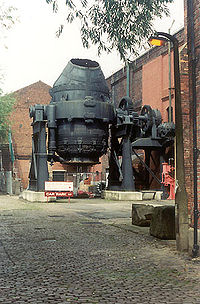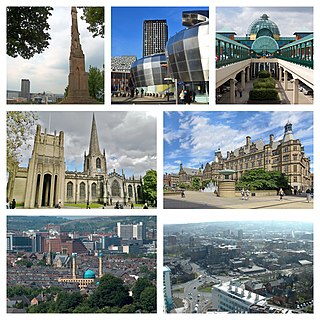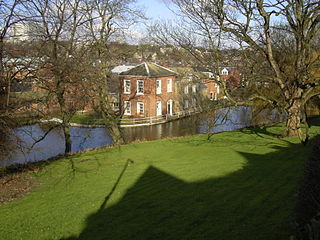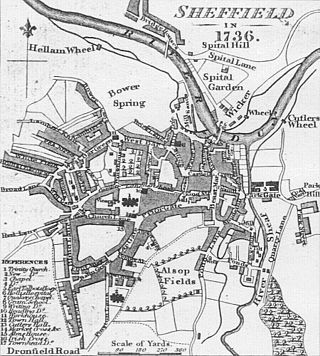

The Kelham Island Museum is an industrial museum on Alma Street, alongside the River Don, in the centre of Sheffield, England. It was opened in 1982.


The Kelham Island Museum is an industrial museum on Alma Street, alongside the River Don, in the centre of Sheffield, England. It was opened in 1982.
The island on which it is located is man-made, resulting from the construction of a mill race, in the 12th century, which diverted water from the River Don to power a corn mill belonging to the Lord of the Manor. It is reported that the island was subsequently named after the Town Armourer, Kellam Homer, who owned a grinding workshop on the neighbouring goit (mill race) in 1637. [1]
Having remained meadowland for much of its existence, John Crowley's Iron Foundry was built on the site in 1829 and continued in operation until the 1890s. The site was flooded on 11 March 1864, when the Dale Dyke Dam broke, damaging workshops on the site. [2] Crowley's Iron Foundry was replaced by a power station in 1899 to provide electricity for the new fleet of trams in the city. The power station operated until the 1930s when the building was used for storage and workshops. [3] These are the premises now occupied by the museum, along with Russell Works, once occupied by Messers Wheatman and Smith. Russell Works now houses the Hawley Gallery and the Crucible Shop, both part of the museum. [1] [2]

The museum houses exhibitions on science and Sheffield industry, including examples of reconstructed little mesters' workshops and England's largest surviving Bessemer converter. This object received an Engineering Heritage Award in 2004 from the Institution of Mechanical Engineers. [4] (Henry Bessemer's pilot converter is on display at the Science Museum (London)). The museum gives tours to local schools and has regular demonstrations of the 1905 River Don Engine, a 12,000 horsepower (9 MW) steam engine, which originally powered a local armour plate rolling mill. The engine is remarkable for its ability to change direction very quickly, a feature that was necessary for the efficient rolling of heavy steel. The engine rolled steel for nuclear reactors towards the end of its life (it was last used in production in 1978 at the River Don Works). The museum is operated by the Sheffield Industrial Museums Trust. It is an Anchor Point of ERIH, The European Route of Industrial Heritage.
The Museum houses the prototype Sheffield-Simplex car, one of only three know to remain. The car was described as, “one of the best and most remarkable vehicles available, representing the highest point to which motor design has yet attained”, by The Times in 1913. [5] The Benjamin Huntsman Clock, the first manufactured object to contain Crucible Cast Steel, can be seen in the Enid Hattersley Gallery. [6] The Museum also has a vast photographic archive which is used by authors for illustrating local history books.
Since 2009, the museum has housed the workshop of Stan Shaw, a little mester. Shaw worked there and demonstrated knife making to the public until his death in 2021. [7] [8]
The Museum suffered heavily in the Sheffield flood of July 2007 with water over a metre deep inundating the site, causing £1.5 million of damage. Paintings by William Cowen and Henry Perlee Parker, a drawing master at Sheffield's Wesleyan College, were some of the objects damaged by the floodwater. [9] The Museum was closed for 18 months, reopening in September 2008. The Museum received a national commendation from the Museums, Libraries and Archives Council (MLA) for its recovery from the 2007 floods. [10] The site is now protected by new flood defences which were completed in December 2011. [2]

The Bessemer process was the first inexpensive industrial process for the mass production of steel from molten pig iron before the development of the open hearth furnace. The key principle is removal of impurities from the iron by oxidation with air being blown through the molten iron. The oxidation also raises the temperature of the iron mass and keeps it molten.

Sheffield is a city in South Yorkshire, England, whose name derives from the River Sheaf which runs through it. The city serves as the administrative centre of the City of Sheffield. It is historically part of the West Riding of Yorkshire and some of its southern suburbs were transferred from Derbyshire to the city council. It is the largest settlement in South Yorkshire.

The Porter Brook is a river which flows through the City of Sheffield, England, descending over 1,000 feet (300 m) from its source on Burbage Moor to the west of the city to its mouth where it joins the River Sheaf in a culvert beneath Sheffield railway station. Like the other rivers in Sheffield, its steep gradient made it ideal for powering water mills and works associated with the metalworking and cutlery industries, and around 20 dams were constructed over the centuries to facilitate this. At its lower end, it is extensively culverted, but parts of it are gradually being restored to open channels, as part of a daylighting scheme for the city.

Crucible steel is steel made by melting pig iron, iron, and sometimes steel, often along with sand, glass, ashes, and other fluxes, in a crucible. In ancient times steel and iron were impossible to melt using charcoal or coal fires, which could not produce temperatures high enough. However, pig iron, having a higher carbon content and thus a lower melting point, could be melted, and by soaking wrought iron or steel in the liquid pig-iron for a long time, the carbon content of the pig iron could be reduced as it slowly diffused into the iron, turning both into steel. Crucible steel of this type was produced in South and Central Asia during the medieval era. This generally produced a very hard steel, but also a composite steel that was inhomogeneous, consisting of a very high-carbon steel and a lower-carbon steel. This often resulted in an intricate pattern when the steel was forged, filed or polished, with possibly the most well-known examples coming from the wootz steel used in Damascus swords. The steel was often much higher in carbon content and in quality in comparison with other methods of steel production of the time because of the use of fluxes. The steel was usually worked very little and at relatively low temperatures to avoid any decarburization, hot short crumbling, or excess diffusion of carbon; just enough hammering to form the shape of a sword. With a carbon content close to that of cast iron, it usually required no heat treatment after shaping other than air cooling to achieve the correct hardness, relying on composition alone. The higher-carbon steel provided a very hard edge, but the lower-carbon steel helped to increase the toughness, helping to decrease the chance of chipping, cracking, or breaking.

Abbeydale Industrial Hamlet is an industrial museum in the south of the City of Sheffield, England. The museum forms part of a former steel-working site on the River Sheaf, with a history going back to at least the 13th century. It consists of a number of dwellings and workshops that were formerly the Abbeydale Works—a scythe-making plant that was in operation until the 1930s—and is a remarkably complete example of a 19th-century works. The works are atypical in that much of the production process was completed on the same site. A more typical example of water-powered works in the area can be found at Shepherd Wheel.

Benjamin Huntsman was an English inventor and manufacturer of cast or crucible steel.

Shepherd Wheel is a working museum in a former water-powered grinding workshop situated on the Porter Brook in the south-west of the City of Sheffield, England. One of the earliest wheels on the River Porter, it is one of the few remaining—and effectively complete—examples of this kind of enterprise, one that used to be commonplace in the Sheffield area. Its 5.5 m (18 ft) diameter overshot water wheel is powered from a large dam stocked with water diverted from the Porter Brook. The workshops, dam, goit and weir are Grade II listed, and the site is a Scheduled Ancient Monument.

City ward — which includes the districts of Highfield, Kelham Island and the city centre — is one of the 28 electoral wards in City of Sheffield, England. It covers the central area of the city. The ward was created following the 2015 local government boundary review out of part of the old Central ward, which, with a population of 36,412, was the largest ward in the UK. City is one of the wards that make up the Sheffield Central constituency.

The history of Sheffield, a city in South Yorkshire, England, can be traced back to the founding of a settlement in a clearing beside the River Sheaf in the second half of the 1st millennium AD. The area now known as Sheffield had seen human occupation since at least the last ice age, but significant growth in the settlements that are now incorporated into the city did not occur until the Industrial Revolution.

The River Don Engine is a 1904-built steam engine used for hot rolling steel armour plate. It is a 3-cylinder simple engine of 40 inches (1.0 m) diameter, 48 inches (1.2 m) stroke. At its operating steam pressure of 160psi, it developed 12,000 horsepower (8.9 MW), and was able to reverse from full speed in 2 seconds. The rapid reverse was an essential feature of an engine used for rolling, as delays would result in cooling of the workpiece. This engine was one of four built to the same design, one going overseas to the Japanese Government, one to John Brown's Atlas plant, and the destination of the final one being William Beardmore of Glasgow. It is claimed to be one of the most powerful steam engines ever built, and the most powerful remaining in Europe.

In 2008, Sheffield ranked among the top 10 UK cities as a business location and aims to regenerate itself as a modern technology and sports based city. Sheffield has an international reputation for metallurgy and steel-making. It was this industry that established it as one of England's main industrial cities during the 18th, 19th and 20th centuries. This industry used Sheffield's unique combination of local Iron, Coal and water power supplied by the local rivers. This fuelled a massive growth in the city's population that expanded from 60,995 in 1801 to a peak of 577,050 in 1951. However, due to increasing competition from imports, it has seen a decline in heavy engineering industries since the 1960s, which has forced the sector to streamline its operations and lay off the majority of the local employment. The steel industry now concentrates on more specialist steel-making and, in 2005, produced more steel per year by value than at any other time in its history. The industry is now less noticeable as it has become highly automated and employs far fewer staff than in the past. However a small number of skilled industrial automation engineers still thrive in it. Today the economy is worth over £7 billion a year.
The Sheffield Industrial Museums Trust (SIMT) is an independent charitable trust based in Sheffield, England, that runs the Sheffield City Council-owned Kelham Island, Abbeydale Industrial Hamlet, and Shepherd Wheel museums.

Steel, Peech and Tozer was a large steel maker with works situated at Ickles and Templeborough, in Rotherham, South Yorkshire, England.
Brown Bayley Steels was a steel-making company established in Sheffield, England in 1871, as Brown, Bayley & Dixon. They occupied a site on Leeds Road which was later occupied by the Don Valley sports stadium. The firm was founded by George Brown, Nephew of John Brown of the firm John Brown & Company. The firm manufactured Bessemer steel and railway tracks.

Neepsend is a suburb of the city of Sheffield, it stands just 1 mile (1.6 km) north-west of the city centre. The main area of Neepsend covers the flood plain of the River Don from Lady's Bridge at the Wicker up to Hillfoot Bridge. The suburb falls within the Central Ward of the city. The adjacent district of Parkwood Springs is often regarded as part of the suburb.

Leah's Yard is a former collection of small industrial workshops situated on Cambridge Street in the city centre of Sheffield in South Yorkshire, England. The building has been designated as a Grade II* listed building because of its importance as an example of Sheffield's industrial heritage and is currently undergoing a significant restoration to bring it back into use.

The Darnall Works is a former steelworks in the Darnall area of Sheffield in England. The only remaining large complex of crucible furnaces, the works opened in the 1835 and were frequently extended and adapted until the late 20th century. Some of the structures at the works are listed buildings, at Grade II* and Grade II, and part of the site is a Scheduled Ancient Monument.
Ken HawleyMBE was a British tool specialist and industrial historian: he was a tool retailer, collector of tools and authority on the history of Sheffield manufacturing trades. He amassed what is recognised as one of the most significant collections of its type in the world. The Hawley Collection is now housed at Kelham Island Museum in Sheffield, England.

The Upper Don Trail formerly known as the Upper Don Walk is a 15 mile long recreational multi use trail which links the centre of Sheffield to the village of Oughtibridge with various sections continuing out towards Stocksbridge and Langsett Reservoir. It follows the course of the River Don and partially the National Cycle Network route 627. The route is variable in quality, the first mile is well defined as it has been integrated into the newly developed quarters to the immediate north of the city centre. The rest of the route is a mixture of path, road and woodland walking.

Stan Shaw was a cutler, or "little mester", from Sheffield, England.